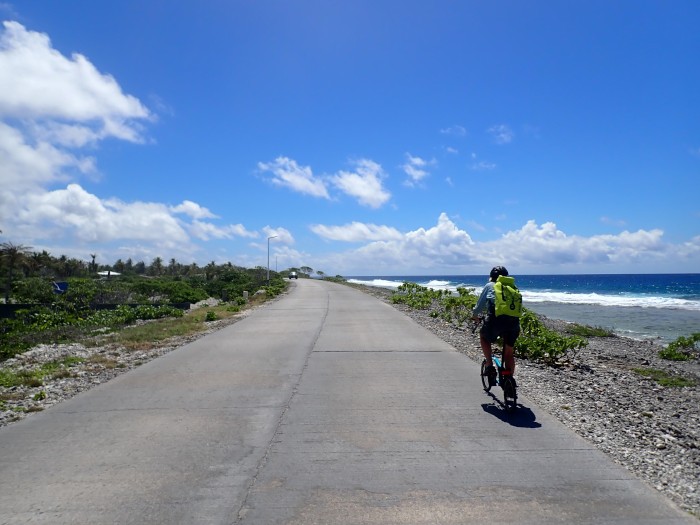The Name of the Motu is Reporepo
05 September 2022
• Motu Reporepo, Rangiroa
by Karl Coplan

Reporepo is the name of the motu we are anchored at. Motu seems to be the PolynesIan word for small coral island, though rocky islets in the Marquesas with no coral on them were also called motus. Place names can be confusing among these archipelagos, as each island has a name, the bay or harbor you enter may have a different name, and the town on the bay may have a completely different name. Sailors mix and match the place names all the time. So, going back to our first landfall in the Galapagos, that place was referred to, variously, as “Wreck Bay” (the name of the bay), San Cristobal (the name of the island), and Puerto Baquerizo Moreno (the name of the port town, named after an Ecuadoran official whose name might translate as Buster Brown).
The Marquesas place names were similarly confused. Our last port is usually just referred to as Nuku Hiva, but Nuku Hiva is the name of the island, not the bay or town (Taioha’e). And now the Tuamotus add atoll names to the list.
So, to be precise, the place we are anchored at right now is politically part of French Polynesia, which means they govern themselves and have their own currency, but the gendarmes are French and so are the baguettes and most of the wine and cheese. We are in the archipelago of the Tuamotus, which as far as I can tell means “many little islands.” We are in the atoll of Rangiroa - an atoll is a circular group of reefs and islands that formed around an ancient now submerged volcanic crater, which Robin will undoubtedly explain in another post.
But each little islet in the ring has its own name - the chart indicates that the motu we are anchored at is Reporepo. Although we came through Tiputa Pass yesterday, the actual village of Tiputa is on the other side of the pass on the motu that is also called Tiputa. The anchorage at Tiputa is too exposed to the easterly winds across the Rangiroa lagoon, so sailboats never anchor there.
The Village here is Otetou, but I have not heard any visitor refer to it by that name. Most sailors would just say we are anchored in Rangiroa, and leave it at that!
Today we took our time getting started - we had enough cell phone internet to see the first line of all our emails, but not the body - enough to delete most of them. Eventually, I ran a kayak shuttle to tow the folding bikes to shore, and by late morning we went exploring on this side of Tiputa Pass.
There is a road that runs all the way across several moths to Avatoru Pass and the larger village of Avatoru. It’s a nice flat road with the open Pacific crashing brilliant blue waves onto coral and white sand on one side, and glimpses past dwellings and lodges to the lagoon on the other side.
We stopped for a picnic lunch at Avatoru pass, and scouted the pass as an eventual exit route. Although the tide was ebbing, it did not look as rough on the ebb as Tiputa Pass. An aging Vagabond-style ketch was anchored in the pass, while its crew went snorkeling, It seemed like a pretty gutsy place to anchor, in the current at the edge of the coral.
We had signed up for the two o’clock tour at Gauguin’s Pearls, a pearl farming operation. So we had to pedal fast back into the wind to catch the explanation of how pearl oysters are cultivated, sorted, seeded, and harvested. We watched the pearl master seeding the pearls with a perfectly round bit of oyster shell to form the most perfect pearls.
Or, increase the odds of a perfect pearl, as we learned that only about 15% of the seeds resulted in pearls, and only five percent were round. You will be happy to learn that all of the oysters get sold to restaurants when the pearls are harvested.
The resulting pearl products on display were oh so tempting - such beautiful colors of subtle greens, reds, and, yes, black pearls. But we resisted the temptation to buy a $15,000 perfect pearl necklace, and put off any decision about less pricey pearl souvenirs for later. There were other pearl shops on our ride back down the connected motus — Tepaietia, Viamate, Tevaiohe, Ariataea, and Taamoi, for the record. One of the shops was offering the rejected pearls - beautiful variegated colors in shapes that were decidedly not round, no two alike. These could be had for a mere $12 each.



Comments